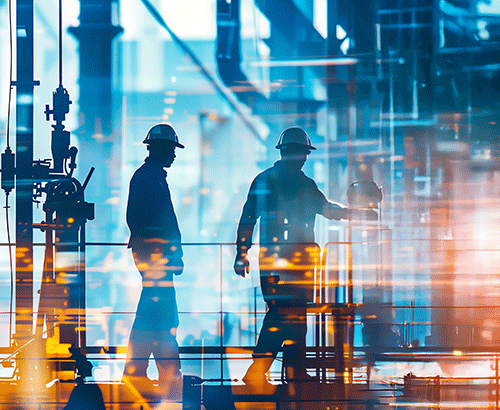Catalysts of Change: Exploring Megatrends Reshaping the E&C Industry

“Time makes more converts than reason.” — Thomas Paine
In his 1776 book “Common Sense,” Thomas Paine tried to spark the American Revolution by challenging colonists’ long-held custom of accepting British rule.
His insight raises questions that are relevant today: What habits are unconsciously engrained in our behaviors? What do we take for granted about the way the world works? And what changes will the future bring that today we might reject as unreasonable?
Most engineering and construction (E&C) firms are planning one to five years in advance using mental models from the present. Yet imagining what is likely to occur down the road and planning accordingly can be helpful. Understanding industry trends and drivers is key in this process.
Megatrends are powerful, multidimensional social shifts. They can be economic, political, cultural or technological. Like tectonic plates, they shift the world, and often we see their manifestations without contemplating their magnitudes. Consider, for instance, how the widespread use of cell phones is a symptom of the broader digitalization of work and communication.
Although megatrends often meet resistance (think of Luddites rejecting the Industrial Revolution), they move forward inevitably. Before long, megatrends are the new normal.
In the first part of our series, we explored four technology-based megatrends reshaping the built environment:
- The ongoing transition to e-commerce and continued digitalization of society.
- The growth of artificial intelligence.
- The permanent arrival of remote and flexible work.
- The rise of data and cybersecurity issues.
In part two we explain the megatrends of continued urbanization, rising income inequality, increased political polarization and further globalization. We invite E&C leaders to reflect on how these megatrends will affect labor markets, competition, supply chain and materials sourcing, and their current technology stack. At every interval it pays to ask, “If this megatrend were to grow exponentially, how would we adapt?”
Continued Urbanization
Urbanization describes the trend of an increasing number of people moving away from rural areas to more densely developed urban or suburban developments. The U.S. has been slowly urbanizing for the past several centuries, but this trend has accelerated dramatically in recent decades and will continue.
Although urbanization can describe the creation of concentrated, connected metro areas, it is just as much about sprawl. Loosely defined, sprawl refers to less dense and less connected suburbs and exurbs with a lack of architectural diversity and long driving distances to amenities.
In 2023 more than 360 incorporated places in the U.S. had populations of more than 100,000, up from just 200 several decades earlier. The fastest-growing cities are in the South and the West. Land devoted to urban uses is projected to more than double to 8.1% in 2050 from 3.1% of the U.S. in 2000.
Urbanization will drive heavy civil investment as populations grow and strain roads, bridges and other infrastructure. The U.S. water infrastructure is particularly in need of renewal and repair, due to its age and shifts in rainwater patterns.
At the same time, urbanization exacts a heavy toll on the environment. The expansion of cities brings deforestation, habitat loss and increased energy consumption. E&C firms will be challenged to minimize the environmental impacts of growth and to account for carbon costs of construction.
As populations expand, the advantages of modular construction, such as increased speed, reduced waste and lower costs, are increasingly evident. Further, design-build has expanded significantly as urban megaprojects take hold.
Finally, urbanization — along with geographic income inequality, discussed below — concentrates opportunity. Now 50% of construction activity takes place in just 22 markets. This means greater competition for bids and workers.
Income Inequality
By multiple measures, the U.S. is increasingly a place of unequal income, wealth and opportunity. Income inequality has been growing in the U.S. for at least 50 years, with upper-income households enjoying more income growth than lower-income households.
If you earned $14,530 a year in 1977, you would be in the lowest 10% of the nation’s households, whereas households in the 90th percentile of income distribution earned $127,000 a year or more, according to the U.S. Census Bureau. In 2022 the 10th percentile limit was $17,100, and the 90th percentile limit on the income distribution scale was $295,000.
Put another way, people in the lowest 10% of income in the U.S. saw their annual incomes grow 18% over five decades. People in the top 10% saw their incomes grow 132% over that same period.
The rise in income inequality is tied to several factors, including, in no particular order, technological change, globalization and the eroding value of the minimum wage. It’s also tied to geography.
There are wide differences in the median income based on where a person lives. According to the U.S. Department of Commerce, geographic income inequality has risen more than 40% between 1980 and 2021, again measured by the difference between the per capita income in places like New York City ($69,000 on average in 2021) and rural small towns ($32,000 on average, 2021). Fifty years ago these differences existed, but the spread was smaller.
For the E&C industry, geographic income inequality could lead to underinvestment in more rural parts of the country or communities where salaries are not rising as quickly. At the same time, we can expect heightened demand for affordable housing; by some estimates, the U.S. needs 4 million to 5 million more homes on the market than it has right now.
The push to build affordable housing will be hurt by neighborhood pushback, onerous regulations and costly construction methods.
However, the future bodes well for companies that can take costs out of multifamily projects through better design and modular construction. E&C companies that want to build affordable housing may also need to forge multistakeholder partnerships, win government subsidies and conduct significant public outreach to win over neighbors.
Intensifying Political Polarization
Ten years ago it would have been unthinkable for a conservative governor in a pro-business state to risk shutting down a $1 billion real estate development. Yet that’s what happened last May. Due to a feud with the Florida governor, Disney nixed a planned office complex development in Orlando that would have brought in some 2,000 highly paid jobs.
This is an example of the megatrend of political polarization. Polarization is real and has been growing. A Pew Research Center analysis finds that, on average, Democrats and Republicans are further apart today than at any other time in the past 50 years. Both parties have moved away from the ideological center, and individuals are geographically segregating themselves by moving to like-minded communities.
For E&C companies, political polarization simply brings more uncertainty to projects. For example:
- Different communities governed by different ideologies may prioritize varying building codes or regulations, potentially leading to additional compliance requirements.
- The ability to forge long-term agreements in public-private partnerships could be affected by polarizing political viewpoints.
- Large federal infrastructure bills and initiatives could stall due to disagreements or threats of government shutdown.
Overall, E&C firms should expect increased risk and greater pushback around projects and plan on more time to engage with affected communities and stakeholders.
Globalization
The world’s economies have become increasingly entwined, and while we’ve seen a recent move toward deglobalization, this is an example of short-term resistance to an inexorable trend.
In 2008 world trade as a share of overall economic activity peaked at 61%. It has since receded to 57%, still far above rates of trade in earlier decades. In some cases, global trade is being rerouted from China to less politically risky countries such as Vietnam and Mexico.
“The efficiencies lost mean higher costs for households and businesses, and profit margin pressure for companies,” wrote Jon Hilsenrath and Anthony DeBarros in The Wall Street Journal. “In boardrooms, it means more attention needs to be paid to risk and a widening landscape of potential crises.”
In short, while globalization is here to stay, it introduces the possibility that supply chains will become increasingly fragile and suffer disruptions. E&C companies will need to create contingency plans.
Changes to global trade also mean increased demand for transportation and warehouse construction. Warehouse and distribution, a subset of commercial, has grown in recent years to represent more than 50% of the commercial segment. Transportation construction is projected to reach a compound annual growth rate of 8% in the next five years.
At the same time, globalization introduces new competitors. According to the Engineering News-Record, in 2023 two of the top 20 international engineering and construction firms ranked according to construction revenue generated outside of each company’s home country were U.S.-based Fluor and Bechtel. By contrast, eight megafirms are in China. Could international firms dominate our U.S. economy and introduce powerful foreign competitors for U.S. construction contracts?
Questions to Ask Now
“Change is the law of life,” said John F. Kennedy, “and those who look only to the past or present are sure to miss the future.”
In our series on megatrends, we’ve presented developments — some familiar, some surprising — that are likely to grow over the next three decades. But how hard and frequently are we thinking about disruption?
The best way to prepare is to consider how megatrends affect all aspects of building:
- Who is doing the building?
- What is being built?
- Where is it being built?
- How is it being built?
FMI’s strategy practice leaders urge you to hold your business up to that future vision and ask: If things were to change significantly in any of these four areas, how well could we adjust?
.png)


.png)